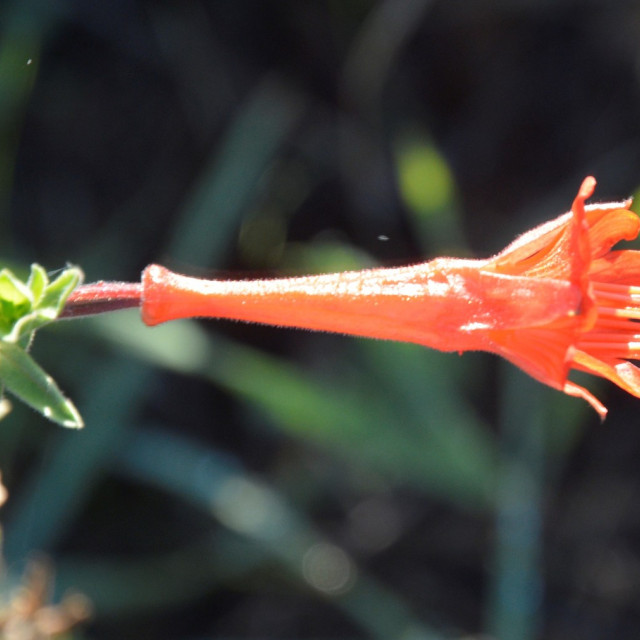COMMON NAME
California fuchsia
SCIENTIFIC NAME
Epilobium canum
Plant family
Evening Primrose (Onagraceae)
Plant group
Wildflowers and Herbs
An upright herb related to fireweed that reaches heights of almost a meter (3ft) and is generally sticky to the touch. The very conspicuous red-orange flowers are clustered at the top of the plant. The four flower petals form a long floral tube. Each petal is notched.
56 reports
34+
OBSERVERS
56+
OBSERVATIONS
Identification hints
Fireweeds and willow-herbs (Epilobium) are showy wildflowers, usually with clusters of pink or white flowers with long narrow tubes and 4 petals that spread out at the tip, and long narrow fruits similar to some mustards. California fuchsia is the only fireweed common in chaparral habitats and has distinctive red flowers (red sepals and red petals) with eight small lobes that curve outward at tips, linear to lance-shaped leaves in clusters, and a woody base. The flowers are about 2 to 3.5 cm (0.78 to 1.4 in) long. Most other species have shorter flowers, are not woody or do not have red flowers.
Did you know?
California Fuchsia is a great example of a hummingbird ";pollination syndrome." A pollination syndrome is a term used to describe a collection of floral traits that attract a particular type of pollinator. In California Fuchsia flowers, the petals are conspicuously red, they are fused to make an elongated floral tube, and the reproductive structures extend beyond the floral tube. With their long beak and tongue, hummingbirds vis it flowers to feed on nectar that is located at the base of the floral tube. While hovering in front of a flower, pollen can be deposited on the bird's head, then when visiting another flower (or sometimes the same flower) pollen can be transferred to a receptive stigma. This is a typical hummingbird pollination syndrome; other pollination syndromes found among other plants include bee, fly, beetle, moth, bat, rodent, wind, and water (among a few others).
DISTRIBUTION IN TH U.S.
Arizona
,
California
,
Idaho
,
New Mexico
,
Nevada
,
Oregon
,
Utah
,
Wyoming
HABITAT
Common throughout much of California on dry slopes and ridges below 9800 ft (3000 m), California fuchsia can be found across a wide range of habitats including chaparral, coastal strand, oak woodland, grassland, and more, as well as in desert mountains.
ATTRIBUTES
Leaves
The green to grayish leaves are elongate to egg-shaped, 0.2 to 2.0 in (5 to 50 mm) long, arranged oppositely (arrangement might deviate above the flowers), and sometimes have strongly toothed leaf margins (edges).
Flowers
The conspicuous flowers are individually attached to the stem by a short pedicel (stem-like structure less than 0.08 in or 2 mm long). The four red-orange flower petals fuse to form a floral tube that is 0.78 to 1.4 in (2 to 3.5 cm) long. At the mouth of the tube, each petal is notched. The female stigma, which has four distinct lobes when ripe, sticks out from the floral tube farther than the male stamens.
Fruits
The fruit is a dry capsule that is 0.78 to 1.4 in long (20 to 35 mm), hairy, slightly beaked (pointed), and connected to the stem by a short pedicel (stem-like structure) up to 0.78 in (2 mm) long. The seeds are tufted with tiny hairs.
Bloom Time
Flower buds appear in mid to late spring and flowers appear mid-spring to mid-summer. Fruits and seeds ripen throughout summer.
See Menu
- 2021 Chicago Botanic Garden. All Rights Reserved.
-
Creative Commons
BY-NC-SA 4.0 - Terms of Use
- Privacy Policy
- Data Sharing and Citation Policies
- 2021 Chicago Botanic Garden. All Rights Reserved.



